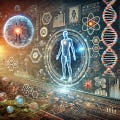As we blend the digital and biological realms, we must be vigilant, for the power to replicate life digitally also carries the responsibility to protect the essence of what it means to be human
The concept of a digital twin is deeply connected to the idea of biodigital convergence and plays a significant role in realizing the potential of this convergence. A digital twin is a virtual model that accurately reflects a physical object, system, or process. In the context of biodigital convergence, digital twins are used to model and simulate biological systems, including human bodies, organs, and even entire ecosystems, enabling unprecedented levels of control, understanding, and prediction.
Connection Between Digital Twins and Biodigital Convergence:
Virtual Representation of Biological Systems:
Human Digital Twins: A human digital twin is a detailed virtual representation of an individual's biological processes, including their genetics, physiology, and health data. This twin can be used to simulate how a person might respond to different treatments, predict disease progression, or optimize personalized healthcare. This directly ties into the goals of biodigital convergence, where digital tools enhance our understanding and manipulation of biological systems.
Organ and Tissue Models: Digital twins can also be created for specific organs or tissues, allowing for simulations that aid in medical research, surgical planning, and the development of new treatments.
Predictive Analytics and Personalized Medicine:
Disease Prediction and Prevention: By using a digital twin, healthcare providers can simulate how a disease might develop in an individual and take preventative measures tailored to that person’s unique biological makeup. This predictive capability is a cornerstone of biodigital convergence, as it merges biological data with advanced digital simulations.
Optimizing Treatment Plans: Digital twins can be used to test the effectiveness of various treatment options on a virtual model before applying them in reality, reducing risks and improving outcomes. This is particularly relevant in precision medicine, where treatments are customized based on an individual's specific bio-digital data.
Integration with Wearable and Implantable Devices:
Real-Time Monitoring: Wearable devices and implantable sensors can feed real-time data into a digital twin, continuously updating it with the latest information about an individual's health status. This creates a dynamic and accurate model that evolves as the person’s biological condition changes.
Biofeedback Loops: This real-time data can be used to create biofeedback loops, where the digital twin provides insights that inform immediate adjustments to treatments or lifestyle, effectively closing the gap between the physical and digital realms.
Applications Beyond Healthcare:
Environmental Monitoring: Digital twins are not limited to human biology. They can be used to model ecosystems, allowing for simulations that predict the impact of environmental changes or interventions. This application is crucial for biodigital convergence, as it connects biological processes with digital tools to manage and protect natural environments.
Agriculture: In agriculture, digital twins of crops or livestock can optimize farming practices by predicting growth patterns, health issues, and yield outcomes, integrating biological knowledge with digital precision.
Ethical and Security Considerations:
Privacy and Data Security: As digital twins require detailed personal and biological data, they raise significant concerns about privacy and data security. The more integrated these models become with an individual's daily life, the greater the potential risk of misuse or breaches of sensitive information.
Ethical Implications: The ability to simulate and potentially manipulate biological processes through digital twins brings up ethical questions about the extent to which we should control or alter natural processes, and who gets to make those decisions.
Conclusion:
Digital twins are a key component of biodigital convergence, serving as the bridge between physical biological systems and their digital counterparts. By enabling detailed simulations and real-time data integration, digital twins allow for more precise, personalized, and proactive management of biological entities, from individual humans to entire ecosystems. However, the integration of digital twins into society also requires careful consideration of privacy, ethics, and security to ensure that this powerful tool is used responsibly.



